Your Ultimate Ratchet Strap Resource for Cargo Control
- What are Ratchet Straps?
- The Components of Ratchet Straps
- Types of Ratchet Straps and Their Uses
- How to Choose the Right Ratchet Straps for Loads?
- How to Use Ratchet Straps? (Step by Step)
- Regular Inspection and Maintenance Suggestions
- Practical Suggestion for Securing Different Types of Loads
- The Potential Risks During Transportation
- Practical Suggestions for Loading, Securing, and Unloading
- Suggestion for Transporting the Challenging Loads and Weather Conditions
- What Other Securing Method Besides Ratchet Straps?
- Advantages and Disadvantages of Alternatives to Ratchet Straps
- Load Securing Regulations in Different Regions
- FAQs about Ratchet Straps
The development of modern society has promoted the rapid expansion of the logistics industry. Whether in daily life or business activities, cargo transportation has become an indispensable part. How to ensure the safety of goods during transportation is the most important part of the logistics industry.
Ratchet straps are a recognized tool in the transportation industry for being very reliable and efficient in cargo securement. Their versatility makes them suitable for various types of loads, from lightweight items to heavy duty industrial equipment.
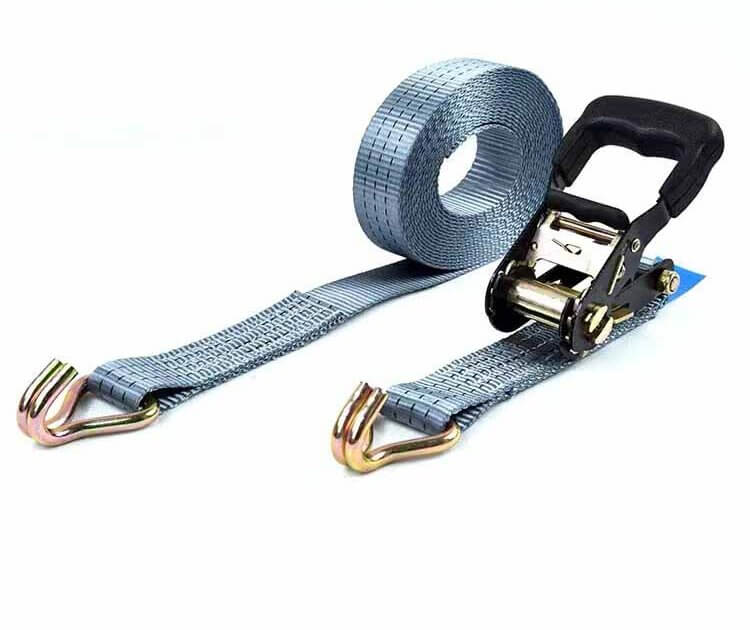
What are Ratchet Straps?
Ratchet straps are one type of tie down straps that consist of a ratchet mechanism, a webbing, and an end fitting. These straps are designed into various widths and lengths to accommodate different load sizes and weights, preventing them from shifting, sliding, or falling off while in transit.
The Components of Ratchet Straps
Ratchet Buckle: The ratchet buckle is the important component that enables the tightening of the strap. It consists of a gear and ratchet mechanism to allow the users to pull and release the webbing.
Webbing: The strap webbing is in a long and flat shape that can be made from various materials, such as polyester, and nylon. The commonly used material is polyester.
End Fitting: There are various types of end fittings for the ratchet straps tie down, such as S hooks, Wire hooks, Flat hooks, Snap hooks, E Track fittings, etc. They are designed to attach the strap to the anchor points.
Release Mechanism: There is a release lever on the ratchet system that allows users to disengage the ratcheting mechanism and release the tension for the unloading cargo.
Types of Ratchet Straps and Their Uses
Endless Loop Ratchet Straps
- Mainly used for securing lightweight loads.
- Featured like a continuous loop, only ratchet and webbing, no end fitting. Easy to handle and adjust.
- Used for securing small equipment, camping gear, and household items.
Two Piece Ratchet Straps
- Their versatility and adjustability are suitable for secure large and heavy loads.
- Two-piece ratchet straps, one end with ratchet buckle and another end with end fitting.
- Normally used for securing motorcycles, ATVs, UTVs, and other bulky items.
Heavy Duty Ratchet Straps
- Designed to secure the heaviest loads and industrial equipment.
- Consists of thicker and wider webbing, heavy duty ratchet, and end fitting.
- Used for securing construction materials, heavy machinery, and industrial equipment.
E Track Ratchet Straps
- Suitable for securing palletized goods and most commercial goods.
- E Track system offers a secure and adjustable anchor point for various load sizes and shapes.
- Mainly used for securing goods in the enclosed trailers, moving vans, and dry vans.
Cam Buckle Straps vs. Ratchet Straps
Cam buckle straps always be regarded as an alternative to ratchet straps, if you are looking for quick tension and release for lighter loads.
Understanding the types and uses of cargo straps will help you to choose the proper tie down straps when you are in need of them. You can also custom ratchet straps from Webslingness!
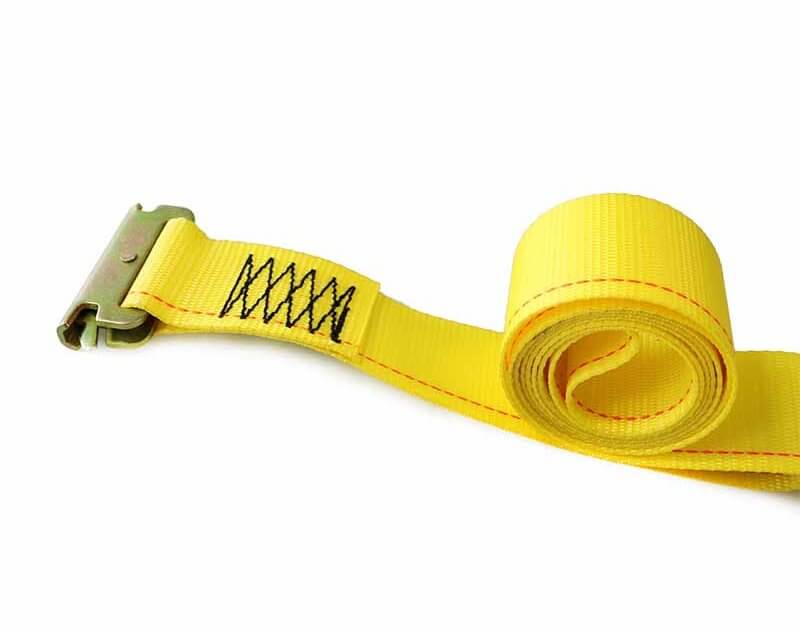
How to Choose the Right Ratchet Straps for Loads?
When choosing the proper load straps, you should consider 3 points: load weight and strap capacity, length and width of the ratchet strap, webbing material, and its durability. Let’s take a look at them:
Weight Capacity and Working Load Limit
There are two important weight indicators when it comes to tie straps: breaking strength and working load limit.
Breaking Strength: The breaking strength of the strap means the maximum load the ratchet strap can hold without breaking. Never exceed the breaking strength of the strap, otherwise, serious accidents may occur.
Working Load Limit: The working load limit of the strap means the maximum weight the ratchet strap is designed to handle. You should consider the potential dynamic forces during transport, so the WLL should be well above the actual weight of the loads to ensure a safe hold.
Length and Width of Ratchet Straps
Length: You need to choose the proper strap length to wrap around your cargo and also allow the proper tensioning. Choose a strap length that is slightly longer than the cargo will be better than the strap that barely fits.
Width: Generally, the width of the loading straps symbolizes its strength and working capacity. Wider straps have higher weight capacity and are suitable for heavy loads. Narrower straps have a lighter weight capacity and are suitable for securing light items.
Webbing Material and Durability
Webbing material and durability factor are also important factors for you to choose the ratchet straps. Let’s take a look at their features:
Polyester Webbing
Polyester webbing is the most commonly used material in cargo straps, due to the feature of high strength, low stretch, and UV resistance. Can be used in both indoor and outdoor applications to secure light duty and heavy duty items.
Nylon Webbing
With the feature of elongation properties from nylon webbing, the ratchet strap made from nylon webbing is suitable for heavy loads and shock-absorbing applications. But nylon webbing can not be exposed to UV rays for long periods of time, Otherwise, its physical properties will be reduced.
Polypropylene Webbing
If you are looking for a low-cost tie down strap, polypropylene webbing is a good material to make the ratchet strap to secure lightweight cargo and only for short-term use. Polypropylene webbing is not as strong as polyester and nylon.
UV Resistance
If the cargo being secured needs to be exposed to sunlight for a long period, consider the ratchet strap with the UV resistance feature.
Abrasion Resistance
Check the condition of the cargo you are going to transport, whether they are sharp or rough. If yes, you need to choose the load straps with excellent abrasion resistance.
Weather Resistance
Some ratchet strap materials can not stand up to extreme weather. Before transporting the cargo, you need to consider how long your transportation will be, whether you will encounter extreme weather, etc. Make sure the material you use can withstand the elements.
How to Use Ratchet Straps? (Step by Step)
Let’s take a look at how to use the ratchet strap step by step.
Step 1: Choose the Right Ratchet Strap
Check your load weight first and then choose the proper working load limit and breaking strength of the ratchet strap. You should also consider the webbing width and length are adequate for securing cargo.
Step 2: Inspect the Ratchet Strap
Before use, you should check for any signs of damage, wear, or fraying. Check webbing, ratchet buckle, and end fitting, if you find any defects, use a new one to replace it immediately.
Step 3: Prepare the Load
Put the load on the transportation vehicle and position it properly. Clear any sharp edges that could damage the tie straps.
Step 4: Attach the Ratchet Strap
Hook one end of the strap to the anchor point on the transportation vehicle, the end fitting you choose needs to fit the anchor point.
Step 5: Thread the Strap
Pull the strap through the ratchet buckle and ensure the webbing lays flat and without twists or knots.
Step 6: Tighten the Ratchet Strap
Pump the ratchet handle up and down to tension the strap gradually and make it wrap around the load to the proper tightness.
Step 7: Double Check the Tension
Ensure the strap is tightly hold to the load and no movement between the load and strap.
Step 8: Lock the Ratchet Buckle
Engage the locking mechanism on the ratchet buckle to prevent accidental loosening during transport.
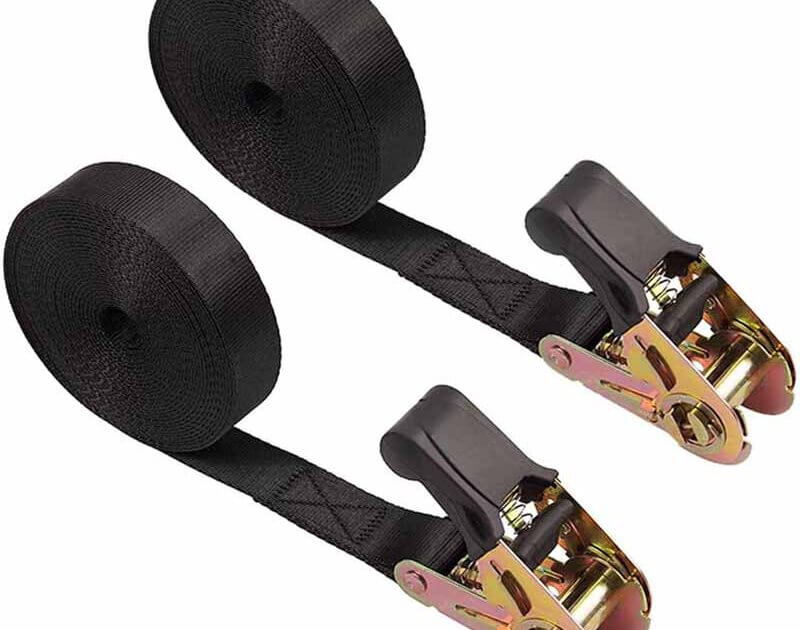
Regular Inspection and Maintenance Suggestions
To ensure safety before using tie down straps and extend their service life, regular inspection and maintenance are essential.
Pre-Trip Inspection
Before every use, you need to check if there is any damage on the ratchet buckle, webbing, and end fitting. Replace the damaged part if you find any defects.
Storage
Store the ratchet strap in a clean, cool, and dry place. Avoid any direct sunlight and corrosive material.
Cleaning
Use mild soap and water to clean the webbing, do not use any chemical cleaning agent to clean the webbing.
Lubrication
Lubricate the ratchet mechanism by using silicone-based lubricant regularly can ensure it operates smoothly.
Retire Old Straps
To ensure the safety of transportation, retire the old straps or heavily used straps to avoid any potential risks.
Practical Suggestion for Securing Different Types of Loads
We do not suggest securing all the cargo in the same way. Different types of loads should be secured according to the actual loading status.
Flat Loads: For securing flat loads, such as plywood, you need to ensure the ratchet strap is evenly distributed on the load surface with proper tension and make sure the strap is entirely wrapped around the loads.
Cylindrical Loads: Install the blocking and bracing on both sides of the transportation vehicle as the barrier to prevent the cylindrical items from moving and falling. Using the ratchet strap to tie down the cylindrical loads in a proper tension.
Vertical Loads: Securing the vertical items, such as furniture, and equipment, you need to use multiple straps from various angles to prevent tipping.
Palletized Loads: E Track Ratchet Straps and E Track System are widely used to secure palletized loads in the vehicle, they are very convenient and can create a stable and adjustable anchor point.
The Potential Risks During Transportation
Don’t think using ratcheting straps to secure the cargo will ensure everything. There may still be some potential risks during transportation, we must have sufficient awareness of this.
Insufficient Load Securement
Improper load securement will lead to the cargo shift or falling off the transport vehicle. This can cause potential harm to passing vehicles and pedestrians.
Damaged Ratchet Straps
Even if you just find very few defects on the strap, you need to change to a new one, since a damaged ratchet strap will result in the strap breaking and weaken the load security.
Sharp Edges and Abrasion
Some loading items have sharp edges and rough surfaces, if you do not protect the strap with some other accessories, these straps will be subject to excessive wear, shortening their service life.
Overloading
The securing item weight must be within the working capacity or working load limit of the ratchet tie downs. If exceed the working capacity of the strap, when you encounter an unexpected situation on the road, it will put extra pressure on the strap, and the strap will be at risk of breaking.
Practical Suggestions for Loading, Securing, and Unloading
Safety is the number one important factor in the transportation industry, make sufficient preparations before transportation to ensure that the goods are delivered safely and on time. Let us see what we need to do:
Proper Load Distribution
Do not stack the transported goods in a corner of the transport vehicle. The goods should be evenly distributed on the transport vehicle to ensure balance and stability during transportation.
Inspect the Straps
Before every transportation, you need to check each part of the ratchet straps. If you find any defects, replace them immediately.
Correct Anchor Points
First, you need to check if the end fitting of the ratchet strap can match the anchor point on the transport vehicle. Second, you need to check if the anchor point is strong enough.
Tension Gradually
When tightening the ratchet strap, you need to tension the strap gradually to prevent over-tightening.
Double Check Securement
Before you start every journey, you should double-check if the cargo has been firmly secured.
Avoid Twist Strap
Avoiding the strap bends or twists is also important, you must keep the strap straight. Otherwise, the strength of the strap will be reduced.
Use Edge Protectors
If the load’s surface is rough or has a sharp edge, you need to use the edge protectors to protect the strap been damaged.
Secure Loose Ends
After tightening the straps, secure any loose ends to avoid flapping in the wind during transportation.
Be Careful While Unloading
When unloading the cargo, release the tension on the ratchet tie down straps carefully, to avoid your hands and body being struck by cargo.
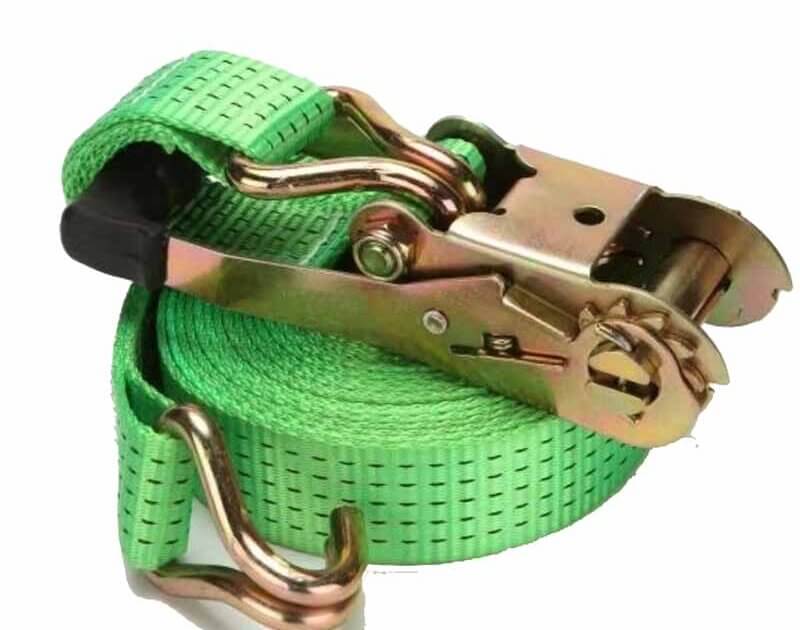
Suggestion for Transporting the Challenging Loads and Weather Conditions
In the actual transportation business, we will always face some problems like, the shape of the goods is irregular, and you may experience many extreme weather conditions. Here are some suggestions for when you face these conditions.
Extra Securement for Irregular Goods
For securing irregular-shaped goods and heavy loads, we suggest using additional straps and also installing the blocking and bracing on the transport vehicle.
Protect from Rainy Day
If you are transporting goods on a rainy day, you need to use waterproof covers or tarps to protect the cargo and ratchet straps from moisture and debris.
Protect from Freezing Weather
When you need to use the ratchet strap in the freezing weather, you need to be cautious of strap stiffness and metal material brittleness. You can choose to use the ratchet straps with rubber handles and keep them indoors when they are not in use.
Protect from Windy Weather
When you are transporting in the windy weather, you need to pay special attention to the tensioning of ratchet straps, in order to avoid cargo movement during transportation.
Regular Monitoring During Transport
If you need to transport goods over a long distance, you should stop your vehicle and monitor your cargo and ratchet straps regularly, to see if they are still in good condition.
What Other Securing Method Besides Ratchet Straps?
Using ratchet straps to tie down cargo is the most commonly used method in the transportation industry. But there are still other securing methods, let us take a look.
Cam Buckle Straps
Cam buckle straps are an alternative to ratchet tie down, if you only need to tie down lightweight cargo. Cambuckle tie downs are easy to operate with manual tensioning, and suitable for some items and situations that require frequent adjustment. But they are not suitable for tie down heavy duty cargo.
Bungee Cords
Bungee cords are elastic straps that are used to secure small items, such as luggage, tarps, and camping gear. They are quick to use with flexibility, but are not strong enough to hold large items and are not suitable for long-distance transportation.
Chains and Binders
For some special loads or under some special situations, chains and binders can secure extremely heavy loads instead of ratchet straps. They can offer robust strength and durability, but they are not easy to take, since they are heavy.
Advantages and Disadvantages of Alternatives to Ratchet Straps
| Features Items | Advantages | Disadvantages |
| Cam Buckle Straps | 1. Easy and quick to use. 2. Suitable for lightweight cargo and easy to adjust the tension by manual. | 1. Not suitable for secure heavy loads. 2. Not suitable for long-distance transportation. 3. Holding strength is not as good as ratchet straps. |
| Bungee Cords | 1. Quick and easy to use. 2. Lightweight and portable. 3. Flexible to tie down small items. | 1. Not suitable for tie down heavy loads or valuable cargo. 2. Limited strength. 3. May lead cargo movement during transportation. |
| Chains and Binders | 1. Extreme strength and durability for heavy loads. 2. Not easy to wear and tear when tie down the rough loads. | 1. Not easy to take, heavier and bulkier than ratchet straps. 2. Require additional tools for tensioning and securing. 3. More expensive than any other tie-down method. |
Load Securing Regulations in Different Regions
Different countries or even the same country, but different regions have different load-securing regulations. They are used to protect the transported goods and prevent accidents on the road. Let’s have a look at some common load-securing guidelines:
USA: In the USA, you can find the load securing guidelines on the Federal Motor Carrier Safety Administration (FMCSA), you can find the detailed guidelines for securing different types of loads.
European Union: The EU established the regulations for requirements for calculating and testing the strength of load-securing equipment.
Australia: You can see the load-securing regulations by the National Transport Commission (NTC) in Australia. They stipulate the securement of different load sizes, weights, and types.
Canada: You can see different load securement requests by the National Safety Code (NSC) in Canada.
FAQs about Ratchet Straps
Q: Can ratchet straps be used for any load sizes?
A: Ratchet straps can be designed into different widths, lengths, and working capacities. You can choose different ratchet straps based on your specific loads.
Q: Are ratchet straps reusable?
A: Yes, ratchet straps are reusable, as long as they remain in good condition.
Q: Can I use ratchet straps to secure motorcycles?
A: Yes, you can use ratchet straps to secure motorcycles, ATVs, UTVs, and other recreational vehicles.
Q: My ratchet strap keeps coming loose, what am I doing wrong?
A: ① check the tension before transportation. ② check if you have locked the ratchet mechanism. ③ double check the connection between end fitting and anchor points.
Q: How to store straps to prevent them from getting tangled?
A: Coil the ratchet strap neatly, then use a rubber band to secure it, store them in a bag or store them in the compartment.
Q: Can I use the ratchet strap to secure machinery?
A: Sure, please choose to use the heavy duty ratchet straps to secure machinery and equipment.
Q: What should I do if the ratchet buckle becomes hard to operate?
A: First, use a soft brush to clean the dirt and debris. Second, use silicone-based lubricant to the moving parts.
Cargo control is very important for both commercial and personal purposes, ratchet straps play a key role in cargo securement during transportation. Knowing the knowledge and choosing the proper ratchet straps will benefit your business a lot. If you want custom or wholesale ratchet straps, Webslingness will be your best partner.
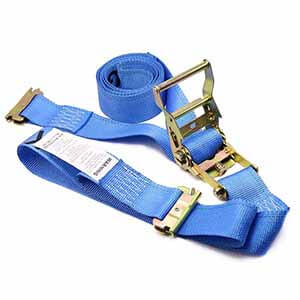
Dave Lee
Dave Lee has amassed over two decades of experience in the cargo control industry, serving as a product manager. Prior to joining Webslingness, he spent three years at a transportation company.


